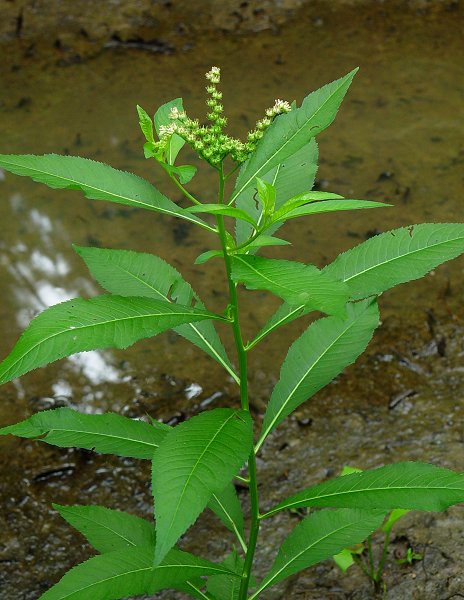Penthorum sedoides L.
Ditch Stonecrop

Native
CC = 3
CW = -5
MOC = 83
© DETenaglia
Penthorum sedoides L.Ditch Stonecrop | |
 |
Native CC = 3 CW = -5 MOC = 83 |
© DETenaglia |
|
Family - Penthoraceae Habit - Rhizomatous perennial forb with rhizomes. Stems - Ascending to erect, to 1 m, unbranched or few-branched, often slightly succulent and reddish-tinged, somewhat angled from decurrent leaf bases, usually with scattered, toothlike stalked glands along the angles, otherwise glabrous.
Leaves - Alternate, simple, short-petiolate. Petioles glabrous or more commonly with scattered toothlike stalked glands. Blades 3-15 cm long, lanceolate to narrowly elliptic, tapered to a sharply pointed tip, tapered to the petiole at the base, the margins sharply and finely toothed, the surfaces glabrous, usually somewhat shiny.
Inflorescences - Panicles, mostly terminal, 2-4-branched toward the base, each branch a 1-sided scorpioid raceme, the axes minutely and often densely glandular pubescent. Flowers on pedicels to 2 mm long.
Flowers - Flowers perfect, actinomorphic, perigynous. Hypanthium relatively short, fused to the base of the pistil, the free portion shallow and saucer-shaped. Sepals 5, attached along the hypanthium rim, 1.3-1.9 mm long, ovate to triangular-ovate, persistent at fruiting. Petals absent or less commonly 1-7, inconspicuous, attached along the hypanthium rim between the sepals, 0.7-1.5 mm long, linear to narrowly oblanceolate, green or greenish white. Stamens 10, the filaments attached along the inner margin of the hypanthium, not noticeably tapered, white, the anthers attached at their bases, orange. Staminodes absent. Pistil 1 per flower, of 5 carpels, these fused to about or slightly below the midpoint, more or less erect at flowering, spreading obliquely at fruiting. Ovaries partially inferior, green to greenish white, each with 1 locule, with numerous ovules, the placentation more or less parietal. Styles 1 per carpel, the ovary tip abruptly tapered, persistent at fruiting, the stigmas capitate, outwardly curved.
Fruits - Capsules 4-7 mm in diameter, wider than long, radially 5-angled and beaked, with circumscissile dehiscence (a cap including the beak and top of the ovary is shed from each carpel), yellowish green, often reddish-tinged, with numerous seeds. Seeds 0.6-0.8 mm long, narrowly ellipsoid to obovoid, the surface, with dense fine tubercles or blunt spines, pinkish tan.
Flowering - July - October. Habitat - Sloughs, pond margins, swamps, marshes, fens, streambanks, bottomland forests, ditches, wet fields, railroads; sometimes emergent aquatics. Origin - Native to the U.S. Lookalikes - None. Other info. - This species is found in wet places more or less throughout Missouri and the eastern half of the continental U.S. The plant is easy to recognize by its wet habitat and branched inflorescences of knobby flowers. The flowers are relatively inconspicuous, and the appearance of the plant changes little as it progresses from flowering to fruiting. The plant was used traditionally by Indians to treat such ailments as diarrhea, dysentery, tonsillitis and bronchitis. Photographs taken off Hwy H., Shannon County, MO., 7-18-03 (DETenaglia); also at Marais Temps Clair Conservation Area, St. Charles County, MO, 9-30-2006, Indian Camp Creek Park, St. Charles County, MO, 12-2-2013, and Riverfront Park, Washington, Franklin County, MO, 7-18-2020 (SRTurner). |